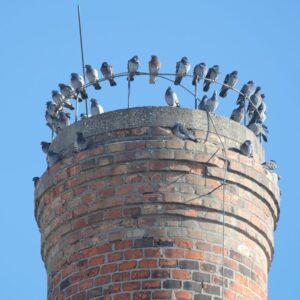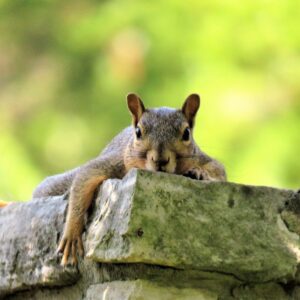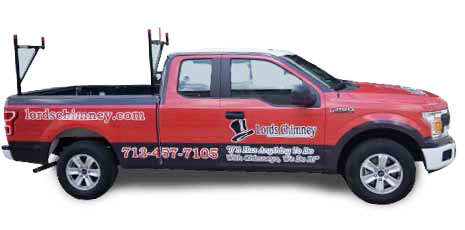A quiet evening at home is disrupted by scurrying, scratching, crying, or clawing sounds coming from the chimney. You have critters in the fireplace – but now what do you do?
Even animals that find their way into your chimney may not be able to get back out. Because of this, it is important to contact a wildlife rescue group or chimney sweep company experienced in safely removing animals as soon as possible.
Here at Lords Chimney, we can help. Call or book online with us now.
How Did the Critters Get Into My Chimney?
 From small squirrels to large raccoons, animals view chimneys as safe, protected areas to build nests and hide from predators. This means that animals will sometimes do whatever it takes to get into a chimney – even to the point of damaging the masonry or other chimney components.
From small squirrels to large raccoons, animals view chimneys as safe, protected areas to build nests and hide from predators. This means that animals will sometimes do whatever it takes to get into a chimney – even to the point of damaging the masonry or other chimney components.
One of the most common ways that critters get into your fireplace is by a damaged chimney cap. Even tiny holes and gaps in the mesh or wire sides may be big enough to allow a small bird or rodent to squeeze through. Likewise, larger animals such as raccoon have been known to worsen chimney damage in an effort to get into the fireplace.
Unfortunately, only raccoons are able to climb the slick walls of the chimney again and again – all other animals may quickly become stuck, trapped, or disoriented in the dark chimney flue once they get in. Trapped animals often sound frantic, scratching, clawing, and beating their wings against the flue in an effort to get out.
How Do I Get the Critters Out of My Chimney?
It is important to leave animal removal to the professionals no matter how big – or small – the critter in your chimney is. Some birds, such as chimneys swifts, are protected by law under the Migratory Bird Treaty Act and cannot be removed until after they have nested. An animal removal professional will identify the type of animal in the chimney and help safely remove the critters with minimal chimney damage.
If you have animal in your chimney it is important to leave the damper fully closed. Even partially opening the damper can create a space large enough for the animals to squeeze into your fireplace. This then gives them access to the rest of your home – trust us, a bird trapped in a chimney is much easier to remove than one flying around your living room!
Homeowners should also not “smoke out” any animals. Doing this can further disorient or even kill the animals in the chimney while potentially igniting nesting materials and other debris.
Keeping Critters Out of Your Chimney
A well maintained and regularly inspected chimney is often the best line of defense against animal entry. Chimney sweeps can help identify any areas of damage or deterioration where animals could potentially get in. Likewise, if you’ve had animal entry in the past we can help identify the areas the critters are getting in.
Why Animals in Your Chimney Cause Problems
Having animals in your chimney system can lead to many issues down the line. First and foremost, their nesting materials cause blockages, which then cause poor ventilation. When it comes to running a fireplace, good ventilation is a key component in ensuring everything functions as it should. Once blockages form, you’ll face smoke backing up into your home, as well as other fumes and toxins.
 Another problem occurs when animals find their way in, but can’t find their way out. This is an unfortunate circumstance that often leads to death of the creature. This then causes foul odors to creep into your home and can lead to pest infestation, as well. The best thing to do is prevent them from entering at all, so you can save yourself a bunch of hassle.
Another problem occurs when animals find their way in, but can’t find their way out. This is an unfortunate circumstance that often leads to death of the creature. This then causes foul odors to creep into your home and can lead to pest infestation, as well. The best thing to do is prevent them from entering at all, so you can save yourself a bunch of hassle.
The last thing we would like to point out is the inability to remove certain types of birds. Chimney swifts, for example, are endangered, meaning we are not legally allowed to remove them until they officially abandon their nests for good. If one sets up camp in your chimney, you are stuck with them – and your fireplace will be out of use until they are gone.
The Threat of Debris in Your Flue
If nesting or any kind gets lodged inside of your flue or chimney, you could face serious dangers when it comes time to light a fire. First of all, these materials are fire hazards. If they ignite, you could find yourself facing a chimney fire. These events can also cause extensive damage throughout your structure, which will require time-consuming and costly repair work before you can light a fire again.
Excess build up can also clog up your system, meaning smoke and poisonous gases could easily work their way into your home. If smoke does not successfully exit your chimney, you will have a smoke-filled living space. This can cause your furniture, curtains, and carpet to stink. It can also lead to carbon monoxide exposure, which can be deadly. The risk of illness, house fires, and even death increase dramatically when you have clogs and obstructions in your chimney. So why put your family and home at risk? Call our team of experts today to put your mind at ease.
From squirrels to swifts, critters can cause significant damage to your chimney system. If you have animals in your chimney or have had problems with animal entry in the past, contact Lords Chimney today!
How Can We Help?
There a few big things we can do to get animals out of your chimney – then keep them out for good.
- At Lords Chimney, we would love to help keep your home and chimney as safe as possible. Along with nest removal, we can remove animals too. Be sure to consult with us first though. Some species, like the chimney swift, are protected by law and cannot be removed. In these cases, you will need to wait until they leave on their own, then we can come and remove their nests.
- We also recommend preventative measures to keep animals out of your chimney such as a chimney cap. Chimney caps are known for their ability to keep out water, but they can also keep out animals and excess debris, as well.
- Finally, you should consider investing in your annual sweeping this spring or summer. Our CSIA certified technicians are qualified to remove creosote, nests, and other debris that could be hindering your fireplace’s performance. Once we have swept your system, you will be able to rest easy knowing your system and family is safe.
Call on our team – or book online today – so you are all set and ready to go when cooler fall temperatures come back around!

